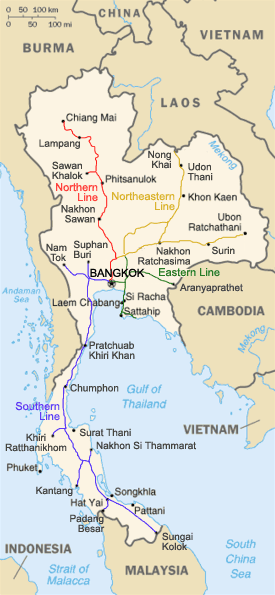Rail transport in Thailand
| Rail transport in Thailand | |||||
|---|---|---|---|---|---|
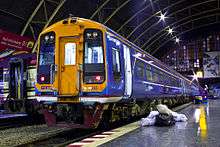 | |||||
| Operation | |||||
| National railway | SRT | ||||
| Infrastructure company | SRT | ||||
| Major operators | BTSC, BMCL | ||||
| Statistics | |||||
| Ridership | ? | ||||
| System length | |||||
| Total | 4,346 kilometres (2,700 mi) | ||||
| Electrified | 80.55 km (50.05 mi) (rapid transit) | ||||
| High-speed | 0 km (0 mi) | ||||
| Track gauge | |||||
| Main |
1,000 mm (3 ft 3 3⁄8 in) 1,435 mm (4 ft 8 1⁄2 in) | ||||
| Metre gauge | 4,346 kilometres (2,700 mi) | ||||
| Standard gauge | 80.55 km (50.05 mi) (rapid transit) | ||||
| Electrification | |||||
| Third rail | 51.95 km (32.28 mi) (BTS Skytrain and Bangkok Metro) | ||||
| Overhead line | 28.6 km (17.8 mi) (Suvarnabhumi Airport Link) | ||||
| Features | |||||
| No. tunnels | 7 | ||||
| Tunnel length | 3.626 km (2.253 mi) | ||||
| Longest tunnel | 1.352 km (0.840 mi) (Khun Tan Tunnel) | ||||
| Longest bridge | 0.442 km (0.275 mi) (Rama VI Bridge) | ||||
| Highest elevation | 578m (Khun Tan Railway Station) | ||||
| |||||
The railway network of Thailand is managed and operated by the State Railway of Thailand (SRT).
History
Interest in rail transport in Siam can be traced to when King Rama IV was given a gift of a model railway from Queen Victoria in 1855. The first railway line, 20 km in length, named the Paknam Railway between Bangkok–Samut Prakan began construction in July 1891 under a 50-year concession with a Danish company. Paknam Railway opened in 1894.[1] This railway line was electrified in 1925, made it into the first electric railway service of Southeast Asia. This railway line was decommissioned on 1 January 1957.
Royal State Railways of Siam (RSR) was found in 1890 at the same time with a construction of the Bangkok-Ayutthaya railway (71 km or 44 mi), the first part of the Northern Line, was started in 1891 and opened on 26 March 1895. The Thonburi-Phetchaburi line (150 km or 93 mi), later the Southern Line, opened on 19 June 1903.
The Northern Line was originally built as 1,435 mm (4 ft 8 1⁄2 in) standard gauge, but in September 1919 it was decided to standardize on 1,000 mm (3 ft 3 3⁄8 in) metre gauge and the Northern Line was regauged during the next ten years. On 1 July 1951, RSR changed its name to the present State Railway of Thailand (SRT).[2]
In 2005 SRT had 4,070 km (2,530 mi) of track, all of it metre gauge. Nearly all is single-track, although some important sections around Bangkok are double or triple-tracked and there are plans to extend this.
On 21 March 2015 Prime Minister Gen Prayut Chan-o-cha said that Thailand and China had signed a memorandum of understanding (MoU) in late-2014 on joint railway construction furthering Thailand's seven-year strategy on the development of transportation from 2015-2022. The MoU stipulates that a joint Thai-Chinese 1.435 metre standard-gauge rail network project bear fruit in 2018. Thailand is to be responsible for conducting environmental impact assessments and land expropriations. China is responsible for project design and construction. The project includes four routes: 133 km between Bangkok and Kaeng Khoi; 246.5 km between Kaeng Khoi and Map Ta Phut; 138.5 km between Kaeng Khoi and Nakhon Ratchasima; and 355 km from Nakhon Ratchasima to Nong Khai.[3]
Issues
The SRT has long been popularly perceived by the public as inefficient and resistant to change. Trains are usually late, and most of its equipment is old and poorly maintained. The worst financially performing state enterprise, the SRT consistently operates at a loss despite being endowed with large amounts of property and receiving large government budgets; it reported a preliminary loss of 7.58 billion baht in 2010.[4] Recurring government attempts at restructuring and/or privatization throughout the 2000s have always been strongly opposed by the union and have not made any progress.[5][6]
Only two percent of Thailand's freight is transported by rail, despite rail being roughly half the cost of road transport and cleaner environmentally.[7]
Operators
All intercity rail transportation is managed by the State Railway of Thailand, a government agency responsible for rail infrastructure investment as well as freight and passenger services.
In Bangkok, the Skytrain is operated by Bangkok Mass Transit System Public Company Limited (BTSC) under a concession granted by the Bangkok Metropolitan Administration (BMA) but the investment for the structure and system were fully supported by BTSC.
The underground system is operated by Bangkok Metro Company Limited (BMCL), while whole project investments were shared by Mass Rapid Transit Authorities (MRTA) and BMCL, which all civil structures was provided by government sector and the system was provided by private sector (BMCL). The deal of contract between BMCL and MRTA are under the concession agreement for 25 years operation.
Network
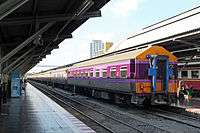
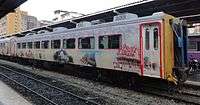
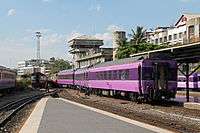
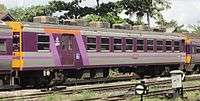
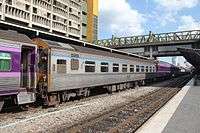
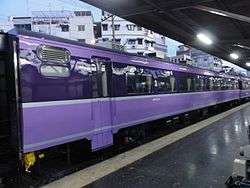
Thailand has 4,431 kilometres of metre gauge railway tracks not including mass transit lines in Bangkok. All national rail services are managed by the State Railway of Thailand. The four main lines are the Northern Line, which terminates in Chiang Mai, the Northeastern Line, which terminates at Ubon Ratchathani and the Lao border in Nong Khai Province, the Eastern Line, which terminates at the Cambodian border in Sa Kaeo Province, and the Southern Line, which terminates at the Malaysian border in Songkhla and Narathiwat Provinces.
Current lines
| Description | Established | Length | Stations | Gauge |
|---|---|---|---|---|
| Bangkok-Ubon Ratchathani | 1930 | 575 km (357 mi) | about 300 | Metre gauge |
| Bangkok-Nong Khai | 1958 | 621 km (386 mi) | about 100 | Metre gauge |
| Nong Khai-Thanaleng, Laos | 2009 | 6 km (3.7 mi) | 2 | Metre gauge |
| Kaeng Khoi-Bua Yai | 1967 | 251 km (156 mi) | about 60 | Metre gauge |
| Bangkok-Chiang Mai | 1926 | 661 km (411 mi) | about 200 | Metre gauge |
| Ban Dara-Sawankhalok | 1910 | 29 km (18 mi) | 3 | Metre gauge |
| Bangkok-Taling Chan | 1903 | 22 km (14 mi) | 7 | Metre gauge |
| Thon Buri-Su-ngai Kolok | 1921 | 1,144 km (711 mi) | about 450 | Metre gauge |
| Hat Yai-Padang Besar, Malaysia | 1918 | 45 km (28 mi) | 3 | Metre gauge |
| Khao Chum Thong-Nakhon Si Thammarat | 1914 | 35 km (22 mi) | 4 | Metre gauge |
| Thung Song-Kantang | 1913 | 93 km (58 mi) | 5 | Metre gauge |
| Ban Thung Pho-Khiri Rat Nikhom | 1956 | 31 km (19 mi) | 2 | Metre gauge |
| Nong Pladuk-Nam Tok (Burma Railway) | 1944 | 130 km (81 mi) | about 30 | Metre gauge |
| Nong Pladuk-Suphanburi | 1963 | 78 km (48 mi) | 2 | Metre gauge |
| Bangkok-Aranyaprathet | 1926 | 255 km (158 mi) | about 100 | Metre gauge |
| Makkasan-Mae Nam | 1909 | 3 km (1.9 mi) | 2 | Metre gauge |
| Sam Sen-Phaya Thai (Chitlada Triangular Junction) | 1936 | 3 km (1.9 mi) | 2 | Metre gauge |
| Chachoengsao-Ban Phlu Ta Luang | 1989 | 123 km (76 mi) | about 20 | Metre gauge |
| Wongwian Yai-Mahachai (Maeklong Railway) | 1904 | 33 km (21 mi) | 18 | Metre gauge |
| Ban Laem-Maeklong (Maeklong Railway) | 1905 | 33 km (21 mi) | 15 | Metre gauge |
Future lines
| Description | Length | Gauge | Start | Commission |
|---|---|---|---|---|
| Den Chai-Chiang Rai | 325 km (202 mi) | Metre gauge | 2014 | 2017 |
| Ban Phai-Nakhon Phanom | 368 km (229 mi) | Metre gauge | 2015 | 2018-2019 |
| Khiri Rat Nikhom-Phuket | 300 km (190 mi) | Metre gauge | 2016 | 2019 |
| Chumphon-Satun | N/A | Metre gauge | N/A | N/A |
| Aranyaprathet–Poipet, Cambodia | 6 km (3.7 mi) | Metre gauge | 2013(Fixed) | 2015 |
| Nam Tok–Thanbyuzayat, Myanmar (Burma Railway) | 285 km (177 mi) | Metre gauge | 2012(planned)TBA(Fixed) | 2020 |
| Pak Bara Deep Sea Port - Songkhla 2 Deep Seaport | ?? | Metre gauge | N/A | N/A |
| Bangkok-Chiang Mai | 715 km (444 mi) | Standard Gauge | N/A | N/A |
Defunct lines
| Description | Established | Length | Gauge | Cancelled | notes |
|---|---|---|---|---|---|
| Hat Yai–Songkhla | 1913 | 30 km (19 mi) | Metre gauge | July 1, 1978 | Began operations In 1913. In 1978 the Cabinet has approved the cancellation of Hat Yai–Songkhla lines, but preserve the railways. Now are fixed again as Songkhla-Pak Bara lines. |
| Nam Tok–Thanbyuzayat, Myanmar (Burma Railway) | December 25, 1944 | 285 km (177 mi) | Metre gauge | ?? | Its operations ended after World War II. In 2012 Thailand and Myanmar agreed to fix this line for high-speed rail. Another name of This line is Burma Railway or Death Railway. |
| Bangkok–Samut Prakan (Paknam Railway) | April 11, 1893 | 21 km (13 mi) | Narrow gauge | 1960 | It is the first railway in Thailand. Open in 1893, operated by Paknam Railway Co.Ltd. In 1943, It is operated by State Railway of Thailand. In 1960 the cabinet approved the cancellation of Paknam Railway to make Rama IV road. |
| Bang Phlat–Bang Bua Thong (Bang Bua Thong Railway) | 1909 | ?? | Narrow gauge | 1943 | |
| Chumphon–Kraburi (Kra Isthmus Railway) | 1943 | 90 km (56 mi) | Metre gauge | 1945 | |
| Bung Wai–Ban Pho Mun | 1930 | 7 km (4.3 mi) | Metre gauge | 1954 | |
| Nong Khai–Talat Nong Khai | 1958 | 2 km (1.2 mi) | Metre gauge | 2008 | |
| Su-ngai Kolok–Rantau Panjang | 1921 | 3 km (1.9 mi) | Metre gauge | ?? | |
| Wongwian Yai–Pak Khlong San | 1904 | ?? | Metre gauge | 1961 | |
| Aranyaprathet–Poipet, Cambodia | 1970 | 6 km (3.7 mi) | Metre gauge | 1974 | |
| Ban Phlu Ta Luang–Sattahip Port | 1989 | 11 km (6.8 mi) | Metre gauge | ?? | |
| Tha Ruea–Phra Phutthabat (Phra Phutthabat Railway) | 1902 | 20 km (12 mi) | Narrow gauge | 1947 | |
| Phetchaburi–Bang Thalu (Chao Samran beach Railway) | ?? | ?? | Narrow gauge | ?? | |
| Hua Wai–Tha Tako | 1940 | 53 km (33 mi) | Metre gauge | 1967 |
Rail links to adjacent countries
-
 Malaysia - yes - same 1,000 mm (3 ft 3 3⁄8 in) gauge
Malaysia - yes - same 1,000 mm (3 ft 3 3⁄8 in) gauge -
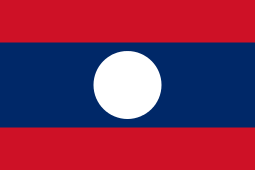 Laos - yes - 1,000 mm (3 ft 3 3⁄8 in) gauge across Mekong River on Thai-Lao Friendship Bridge
Laos - yes - 1,000 mm (3 ft 3 3⁄8 in) gauge across Mekong River on Thai-Lao Friendship Bridge -
 Cambodia - yes - disused (being rebuilt)
Cambodia - yes - disused (being rebuilt) -
 Myanmar - no - defunct - (see Death Railway). But projected extension will rebuild the route.[8]
Myanmar - no - defunct - (see Death Railway). But projected extension will rebuild the route.[8]
Rail transport in Bangkok
In the late 1800s and early 1900s, King Rama V eagerly built a tram network for Bangkok by employing foreign engineers and technicians, especially Danish engineers. In fact, Bangkok had electric trams before Copenhagen. However, due to a lack of interest and maintenance the tram network was completely scrapped in 1968.
Greater Bangkok commuter rail
Rapid transit systems
Bangkok is currently served by three rapid transit systems: the BTS Skytrain, the underground MRT and the elevated Airport Rail Link. Although proposals for the development of rapid transit in Bangkok had been made since 1975,[9] leading to plans for the failed Lavalin Skytrain, it was only in 1999 that the BTS finally began operation.

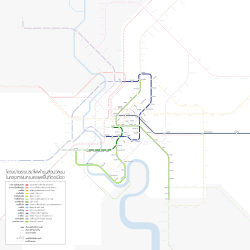
In addition to rapid transit and heavy rail lines, there have been proposals for several monorail systems, the most notable being a line linking Chulalongkorn University with Siam Square, to be funded by the BMA. In 2010 Grand Canal Land Company proposed a 600–800 metre line linking its properties on Rama IX Road with the Phra Ram 9 MRT Station, but failed to secure approval.[10][11]
| Primary lines | ||
|---|---|---|
| Commuter | SRT Dark Red Line | Thammasat – Maha Chai |
| SRT Light Red Line | Sala Ya – Taling Chan – Hua Mak | |
| Airport Rail Link and extension | Phaya Thai – Bang Sue – Don Mueang | |
| Rapid transit | Dark Green Line, extension of the BTS Sukhumvit Line | Lam Luk Ka – Saphan Mai – Mo Chit – On Nut – Bearing – Samut Prakan – Bang Pu |
| Light Green Line, extension of the BTS Silom Line | Yot Se – Taksin Bridge – Bang Wa | |
| Blue Line, extension of the MRT Blue Line | Bang Sue – Tha Phra, Hua Lamphong – Bang Khae – Phutthamonthon Sai 4 | |
| Purple Line | Bang Yai – Rat Burana | |
| Orange Line | Taling Chan – Min Buri | |
| Feeder lines | ||
| Monorail | Pink Line | Khae Rai – Pak Kret – Min Buri |
| Yellow Line | Lat Phrao – Samrong | |
| Brown Line | Khae Rai – Bueng Kum | |
| Grey Line | Watcharaphon – Rama IX Bridge | |
| Light Blue Line | Din Daeng – Sathon | |
| AGT | Gold Line | Krung Thonburi – Wat Anongkaram |
Development is divided into three stages, in addition to those lines already open or under construction:[12]
| As of 2014 | ||
|---|---|---|
| In service | 81.28 kilometres (50.51 mi) | ~28.93% |
| Under construction | 98.62 kilometres (61.28 mi) | ~35.36% |
| Planned | more than 100 kilometres (62 mi) | ~35.71% |
Rolling stock
State Railway of Thailand
- UM12C (GE)
- AD24C (ALS)
- 8FA-36C (HID)
- CM22-7i (GEA)
- Daewoo Heavy Industries (APD.20)
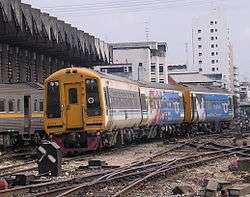
BTS Skytrain
The BTS Skytrain uses two variations of Electric Multiple Unit rolling stock. All operate on 1,435 mm (4 ft 8 1⁄2 in) track gauge (standard gauge). All trains have 4 doors on each side per car, an air-conditioning unit, and LCD monitors for public announcement and advertising. The power supply for all trains is at 750 V DC from the third rail.
Bangkok Metro

- Bangkok MRT Blue Line and Purple Line : each train consists of two motor cars and a centre trailer car.[13]
Airport Rail Link
Siemens supplied nine Desiro Class 360/2 trainsets. The only significant difference from the UK units is a much larger air-conditioning pod on the roof, providing extra power to cope with the Thai climate. City services is operated by five three-car trains, and the Express services by four trainsets with a fourth car for check-in baggage. The first trains left Germany in September 2007, and testing in Bangkok began in March 2008.[14] On 15 May 2012 the Thai Cabinet approved a budget of 5.2 billion baht for the SRT to order 7 new, 4 car sets of Siemens Desiro rolling stock to be delivered by 2014.[15] However, as of June 2013 no order for new rolling stock had yet been placed. The Ministry of Transport was considering purchasing cheaper Chinese (CNR) or Spanish (CAF) rolling stock which would require changing the Siemens closed signalling system to an open system.[15]
Infrastructure
Tracks

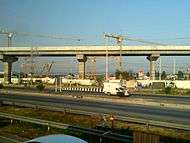
Most existing State Railway of Thailand lines use metre gauge, although standard gauge is used of rapid transit lines. As of 2013, approximately 4,346 km (2,700 mi) of track was in use throughout Thailand:
- 4,346 km (2,700 mi) metre gauge (1,000 mm (3 ft 3 3⁄8 in));
- 80.55 km (50.05 mi) standard gauge (1,435 mm (4 ft 8 1⁄2 in)); and
Railway stations
About 450 stations.[16]
Bridges
About 1,000 bridges.[17]
Tunnels
There are 7 railway tunnels in Thailand, amounting to a total length of 3.63 km (2.26 mi).
Signalling
State Railway of Thailand uses colour light signals and semaphore signal
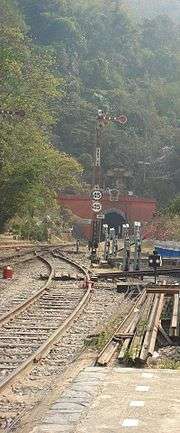 Semaphore signal
Semaphore signal
Future Plans
Mass transit routes in Bangkok are also set to be expanded. Excluding the already under construction extensions to the Skytrain, the Bangkok Metropolitan Government is planning a northern as well as western expansion of the Skytrain. The Central Government, through the State Railway of Thailand and Mass Rapid Transit Authority of Thailand are also planning to build several new metro routes.
The Thai Government also has double tracking projects including a double tracking project in the works between Laem Chabang deep sea port and the Lad Krabang ICD. Also, in line with the Government's policy of reducing overall logistics costs in Thailand, there are plans to completely double track all the main lines in the country as well as upgrade track quality. The Government is also mulling a restructuring of the State Railway of Thailand and granting operating concessions to private freight operators. An international rail link has opened to Vientiane in Laos via Nong Khai and the Thai-Lao Friendship Bridge. The 6 km 'missing link' on the Eastern line between Aranyaphratet and Poipet (Cambodia) is also being rebuilt with construction starting in late 2013 for completion in 900 days.[18]
New SRT lines
There are also plans to construct new railway routes:
- 1) Chiang Rai in the north via Denchai Junction - 326 km, 77 billion baht. This route is currently under EIA evaluation
- 2) Ban Phai (on the Northeast line) - Roi Et - Mukdahan - Nakhon Phanom - 347 km, 42 billion baht. (Completing public consultations & final route evaluation by Oct 2014)
- 3) Kanchanaburi - Dewei (Burma): 190 km. Route to be finalised
- 4) Phuket from Surat Thani
- 5) Connect the Maeklong railway to main lines
Thailand High Speed Railways
| Thailand High Speed Rail | |
|---|---|
| Overview | |
| Type | High-speed rail |
| Status | Preliminary |
| Operation | |
| Operator(s) | State Railway of Thailand |
| Technical | |
| Track gauge | 1,435 mm (4 ft 8 1⁄2 in) |
| Operating speed | 250 km/h (155 mph) max |
In October 2010, the Thai parliament approved initial proposals for a high speed rail (HSR) network. Five lines capable of handling 250 km/h speeds would radiate from Bangkok.[19]
In March 2013, the transport minister revealed that only one company would be selected to run all high-speed train routes, scheduled to be operational between 2018 and 2019.[20] The first 86 km section from Bang Sue to Ayuthaya was planned to be tendered in late-2013. However, a seven-month-long political crisis involving the dissolution of parliament and an annulled February 2014 election culminated in a military coup in May 2014. Subsequently, in July 2014 the new military administration deferred all HSR plans until the next civilian government is installed.
Following the military coup of May 2014 and his elevation to the office of prime minister, Gen Prayut Chan-o-cha proposed connecting Bangkok to two popular resort cities, Pattaya and Hua Hin, by high-speed rail. The Transport Ministry's Office of Transport and Traffic Policy and Planning had earlier conducted studies on both routes. They assumed that, for the Bangkok-Pattaya line, trains would run through Chachoengsao, Chonburi, and Pattaya, terminating in Rayong, a total distance of 193.5 km. Construction costs were estimated at 152 billion baht with an economic internal rate of return (EIRR) of 13 percent. Construction would take about 54 months. The route to Hua Hin would be 209 km in length with an investment cost of about 98 billion baht and EIRR of 8.1 percent. The office concluded that these routes would be of little interest to private investors due to the high investment required, coupled with a low rate of return.[21]
Bangkok-Chiang Mai Shinkansen
Japan has proposed Shinkansen technology for a high-speed rail link between Bangkok and the northern city of Chiang Mai.
In August 2016, according to the Transport Minister Arkom Termpittayapaisith, Thailand and Japan discussed a high-speed train to link Bangkok and Chiang Mai. Japan agreed to use the Shinkansen as its bullet train model.[22]
Sino-Thai railways
China's dream is to construct a 3,000 km railway from Kunming to Singapore, traversing Laos, Thailand, and Malaysia. That plan is in jeopardy in the near-term.[23]
In November 2014, Thailand and China signed a memorandum of understanding agreeing to construct the Thai portion of the transnational railway running from Kunming, China to the Gulf of Thailand. In November 2015, both parties agreed to a division of labour. Under the framework, a joint venture would be set up to run the project. China would conduct feasibility studies, design the system, construct tunnels and bridges, and lay track. Thailand would conduct social and environmental impact studies, expropriate land for construction, handle general civil engineering and power supply, and supply construction materials.
Once built, China would operate and maintain the system for the first three years of operation. Between the third and the seventh years, both countries would share responsibility. Later Thailand would take on responsibility with China as adviser. China would train Thai personnel to operate and maintain the system.
Dual standard-gauge tracks would be laid throughout the project. In Thailand, two routes would diverge at a junction in Kaeng Khoi District in Saraburi Province. One to connect Bangkok to Kaeng Khoi. The other route to connect Kaeng Khoi with Map Ta Phut of Rayong Province. From Kaeng Khoi tracks would lead north to Nakhon Ratchasima and on to Nong Khai Province. Construction would be divided into four sections: Bangkok-Kaeng Khoi, Map Ta Phut-Kaeng Khoi, Kaeng Khoi-Nakhon Ratchasima, Nakhon Ratchasima-Nong Khai.
Construction of Thailand's 873-kilometre-long portion of the railway system was expected to start in mid-2016 and take three years. It would connect to a 417 km line from Vientiane to the northern Lao border and a 520 km line from the Lao border to Kunming.[24] Both the Thai and Lao portions of the route are on hold due to conflicts with the Chinese over funding and land disbursements.[23]
High Speed Routes
| High-Speed Corridor | Route | Speed (km/h) | Length (km) | Network | Projected Operation | Status |
|---|---|---|---|---|---|---|
| Bangkok-Phitsanulok High-Speed Railway | Bangkok–Ayutthaya–Phitsanulok | 250 | 384 | Japan | 2021 (est.) | Proposed[25] |
| Phitsanulok-Chiang Mai High-Speed Railway | Phitsanulok–Uttaradit–Lampang–Chiang Mai | 250 | 292 | Japan | Unknown | Proposed[25] |
| Bangkok-Nakhon Ratchasima High-Speed Railway | Bangkok–Ayutthaya–Saraburi–Nakhon Ratchasima | 250 | 250 | China | 2019 (est.) | Construction start Sep 2016[26] |
| Nakhon Ratchasima-Vientiane Railway | Nakhon Ratchasima–Khon Kaen–Udon Thani–Nong Khai–Vientiane | Unknown | 380 | China | Unknown | Planning Stage |
| Bangkok-Hua Hin High-Speed Railway | Bangkok–Nakhon Pathom–Ratchaburi–Phetchaburi–Hua Hin | 250 | 211[27] | Thai privatized | Unknown | EIA awaiting approval[27] |
| Bangkok-Rayong High-Speed Railway | Bangkok–Chachoengsao–Chonburi–Rayong | 250 | 193.5[27] | Thai privatized | 2021 (est.) | EIA underway[27] |
See also
- State Railway of Thailand
- High-speed rail in Thailand
- Bangkok Skytrain
- Bangkok Subway
- Transport in Thailand
- Burma Railway also known as Death Railway, Thailand–Burma Railway
- Rapid transit in Thailand
- List of rail accidents in Thailand
References
- ↑ "Trains in Siam". Railway Wonders of the World. 22 November 1935. Retrieved 14 July 2016.
- ↑ "Railway of Thailand History". State Railway of Thailand (SRT). Retrieved 14 July 2016.
- ↑ Promlerd, Paparorn; Niamvanichkul, Nodhwarang (2015-03-21). "Thai-Chinese standard-gauge rail network will be in use by 2018, PM says". National News Bureau of Thailand (NNT). Retrieved 22 Mar 2015.
- ↑ Chantanusornsiri, Wichit (23 January 2012). "State railway to finally account for assets and liabilities". Bangkok Post.
- ↑ Mahitthirook, Amornrat; Marukatat, Saritdet (22 December 2010). "Getting on track needs strong political will". Bangkok Post.
- ↑ Bowring, Philip (23 October 2009). "Thailand's Railways: Wrong Track". Asia Sentinel. Asia Sentinel. Retrieved 22 August 2012.
- ↑ Janssen, Peter (2 November 2016). "Thailand takes a long-term gamble on Isaan region". Nikkei Asian Review. Retrieved 3 November 2016.
- ↑ "Neighbours to the west get closer | Bangkok Post: news". Bangkok Post. 2012-02-28. Retrieved 2012-08-13.
- ↑ Rujopakarn, Wiroj (October 2003). "Bangkok transport system development: what went wrong?". Journal of the Eastern Asia Society for Transportation Studies. 5: 3302–15.
- ↑ "Developer puts Bangkok on track for nation's first monorail". Bangkok Post. March 7, 2010. Retrieved December 25, 2011.
- ↑ โมโนเรลแกรนด์คาแนลส่อวืด. Thansettakij (in Thai) (2628). 21–23 April 2011. Retrieved 28 July 2012.
- ↑ ความก้าวหน้าโครงการ. Mass Rapid Transit Master Plan in Bangkok Metropolitan Region website (in Thai). Office of Transport and Traffic Policy and Planning. Retrieved 16 January 2012.
- ↑ "Bangkok's first underground metro open". International Railway Journal. July 2004. Retrieved 2008-08-30.
- ↑ "Bangkok Desiro deliveries begin". Railway Gazette International. September 10, 2007.
- 1 2 "แอร์พอร์ตลิงก์ชงบอร์ดซื้อรถใหม่ 7 ขบวน 4.2พันล้าน เตรียมเข็นล็อตแรกปี′57". ประชาชาติธุรกิจ. 16 May 2012. Retrieved 15 July 2016.
- ↑ Railway stations in Thailand
- ↑ "Railway bridges in Thailand records (Thai)".
- ↑ "คมนาคมเร่งโปรเจ็กต์ ทางรถไฟเชื่อม"เขมร" หนุนการค้า-ท่องเที่ยว". ประชาชาติธุรกิจ. 2013-05-26. Retrieved 15 July 2016.
- ↑ "Thailand to negotiate with China on high-speed proposal". International Railway Journal. 2010-10-30. Retrieved 2010-10-30.
- ↑ "Transport Minister: One firm will run all high-speed train routes". Thai Financial Post. 2013-03-21.
- ↑ "Difficulty in implementing high-speed train to resort provinces". Mass Communication Organization of Thailand (MCOT). 2015-02-14. Retrieved 15 Feb 2015.
- ↑ Mahitthirook, Amornrat (2016-08-07). "Thailand plumps for Japanese bullet train model". Bangkok Post. Retrieved 2016-08-09.
- 1 2 "China's Silk Road ambitions face obstacles". Bangkok Post. Reuters. 5 Jun 2016. Retrieved 6 June 2016.
- ↑ Jikkham, Patsara (2015-11-17). "Sino-Thai railway responsibilities set". Bangkok Post. Retrieved 18 November 2015.
- 1 2 Mahitthirook, Amornrat (2016-06-24). "Japan splits up high-speed rail plan". Bangkok Post. Retrieved 15 July 2016.
- ↑ "Construction of Bangkok-Nakhon Ratchasima high speed train to begin in Sept". National News Bureau of Thailand. 16 June 2016. Retrieved 15 July 2016.
- 1 2 3 4 Theparat, Chatrudee (9 Jun 2016). "High-speed rail routes chosen for PPP fast track". Bangkok Post. Retrieved 15 July 2016.
External links
| Wikimedia Commons has media related to Rail transport in Thailand. |
